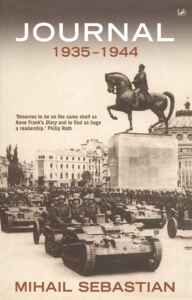A Humane Witness: The Journal of Mihail Sebastian

One of the joys of the reading life is meeting a new friend who also knows—and loves—a book that has deeply moved you. Shared enthusiasm creates an instant bond. However, the libraries are full of unjustly-neglected books, and it is all too easy for works of real merit to sink into oblivion. It’s because it pains me to see great works ignored that today I’d like to recommend the Romanian-Jewish writer Mihail Sebastian’s Journal, 1935-1944[1]—a book that deeply impressed me when I first stumbled across it nearly two decades ago, and which remains one of the most luminous and revealing documents from those somber years that I have ever come across.
Mihail Sebastian, né Iosif Hechter, was born into a middle-class Jewish family in the Danube port town of Bráila in 1907. In accordance with one of those ironies with which the gods amuse themselves, he managed to survive both the murderous anti-Semitic campaigns that preceded Romania’s entry (alongside Germany) into the Second World War and the war itself, only to be killed by a truck while crossing a Bucharest street in May 1945. Sebastian was only twenty-eight the year he began keeping his journal, but he was already a well-known novelist and playwright.
As Radu Ioanid notes in his lucid introduction, the period spanned by Sebastian’s journal saw the rise of three successive anti-Semitic dictatorships in Romania: the regime of King Carol II (February 1938-September 1940); the regime that Ion Antonescu established in alliance with the fascist Iron Guard (September 1940-January 1941); and the dictatorship that Antonescu set up after he violently suppressed his erstwhile allies in the Guard (1941-1944). Sebastian’s journal allows the reader to trace the impact of these developments, both on daily life in Bucharest and on the world of Romania’s intellectuals.
Sebastian had little interest in religion or Jewish issues per se. He saw himself, and wanted others to see him, as a “man of the Danube”–a Romanian writer who merely happened to be Jewish. Consequently, he watched with stunned disbelief as his closest friends, brilliant writers like the philosopher Emil Cioran and the future University of Chicago scholar of religion Mircea Eliade, one after another declared their admiration for Nazism and embraced the Iron Guard’s fanatical anti-Semitism. Because he stayed in contact with his literary friends over the course of the fascist years, he was able to leave us a precious record of the process by which they embraced a murderous and delusional political religion.
In the early pages of the journal, Sebastian comes off as an aesthete, delighting in Bach and Proust and the joys of private life, and unconcerned—at least to the extent possible—with political matters. There are beautiful entries describing the delight he took in listening to symphonies over the radio, his love of skiing over fresh snow in the Carpathians, and his turbulent, usually unhappy love affairs with stage actresses. (He renders the women vividly, with great sympathetic understanding and a keen eye for their individuality.)
His portraits of his literary friends are equally vivid, but mostly damning. With the exception of the playwright Eugène Ionesco, most of the writers who appear in the book behave appallingly. Sebastian quotes his erstwhile mentor, the philosopher and Iron Guard ideologue Nae Ionescu, boasting like a barroom drunk about his supposed influence on Nazi bosses in Berlin. He shows us Mircea Eliade and Emil Cioran praising Hitler’s genius and ranting about Jews. He describes how people who had dropped him when the fascist tide was rising began to make excuses and try to curry favor once it became clear that the Nazis were going to lose the war.
Sebastian’s journal is a monument to the power of culture, if not to console, exactly, then at least to sharpen one’s sense of perspective in evil times. During the early months of Germany’s (and Romania’s) invasion of the Soviet Union 1n 1941, he reads Thucydides’ The Peloponnesian War and Tolstoy’s War and Peace. The collapse of Athens after the doomed Sicilian expedition of 415-413 BC reminds him of the rout of the French in 1940, while Tolstoy’s account of Napoleon’s Russian campaign suggests the hopeful thought that invading Russia does not always prove to be as easy as would-be conquerors might imagine. He finds sustenance in the rich imaginative worlds of Baudelaire and Balzac. In between bouts of mandatory conscript labor, he translates Shakespeare and Pride and Prejudice. All the while, he remains attentive to the suffering of others, whether they be terrified Jewish forced laborers, widowed mothers, or hungry children.
It would be impossible to do justice to the richness of Sebastian’s journal within the space of a brief review. For obvious reasons, many Romanian nationalists were displeased when it was finally published in 1997. But for anyone interested in viewing those terrible years from the perspective of a talented, perceptive, and deeply humane witness, Mihail Sebastian’s Journal, 1935-1944 is essential reading.
[1] Sebastian, Mihail. Journal, 1935-1944. Translated by Patrick Camiller. Introduction and notes by Radu Ioanid. Rowman and Littlefield Publishers, 2000.




